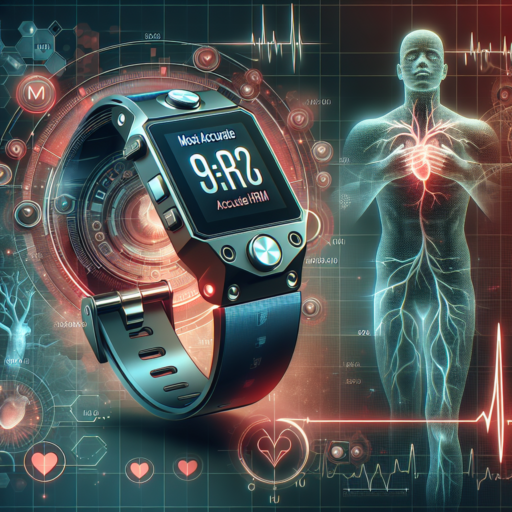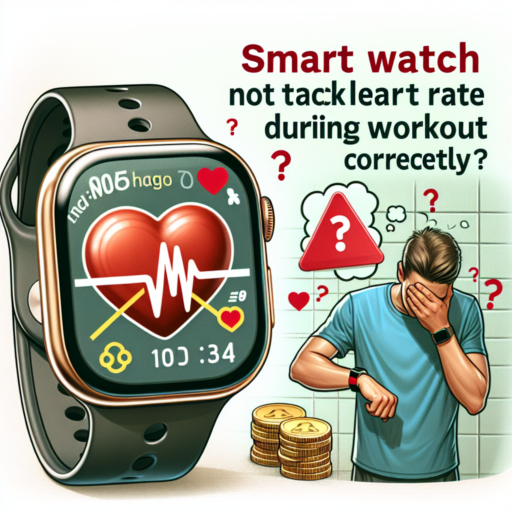No se han encontrado productos.
Introduction to the Most Accurate Heart Rate Monitors (HRMs)
Finding the most accurate heart rate monitors (HRMs) has become essential for individuals aiming to optimize their fitness routines and health monitoring. With the plethora of options available, understanding what sets the best HRMs apart is crucial. These devices come in various forms, including chest straps, wristbands, and smartwatches, each offering varying levels of accuracy and convenience. In this introduction, we’ll delve deep into the features and technologies that make for the most reliable HRMs on the market.
One key factor in the accuracy of heart rate monitors is the method of measurement. Chest strap HRMs are widely recognized for their close proximity to the heart, providing readings that are more aligned with electrocardiography (EKG) standards. On the other hand, wrist-based HRMs employ optical sensors to detect blood flow changes, a method that, while highly convenient, can be influenced by factors like movement and skin tone. Here, we’ll highlight how advancements in sensor technology and algorithm improvements have narrowed the accuracy gap between these two types of heart rate monitors.
Furthermore, the integration of artificial intelligence (AI) and machine learning technologies into HRMs has marked a significant leap in their capabilities. These smart HRMs not only offer precise heart rate readings but also provide personalized heart health insights, making them invaluable tools for both fitness enthusiasts and individuals with health concerns. In this section, we explore how these technologies work in harmony to deliver heart rate data of unparalleled accuracy.
Top Features to Consider for the Most Accurate HRMs
In the realm of fitness and wellness, heart rate monitors (HRMs) play a pivotal role in providing insightful data for optimizing health and exercise routines. When selecting the most accurate HRM, certain features stand out as essential for achieving reliable and precise heart rate data.
Optical Heart Rate Technology
One of the fundamental features to consider is the type of technology used for heart rate tracking. Optical heart rate technology, which uses light-based technology to monitor the amount of blood flowing through the wrist, has become increasingly popular due to its comfort and ease of use. However, accuracy can vary across different models and conditions, making it crucial to choose an HRM known for its precision and consistency in the optical sensors used.
Water Resistance
For athletes and fitness enthusiasts who engage in water-based activities or sweat heavily during workouts, water resistance is a key feature. An HRM with high water resistance can provide accurate readings without being affected by moisture, ensuring reliability whether you’re swimming laps in the pool or pushing through a rigorous outdoor workout in varying weather conditions.
Battery Life and Connectivity
Battery life is another vital aspect to consider. A long-lasting battery ensures that your HRM stays functional throughout extended training sessions and doesn’t fail mid-workout, potentially affecting your data collection and training efficiency. Additionally, the connectivity features of an HRM, such as Bluetooth or ANT+, are essential for syncing with other devices and apps to track and analyze your heart rate data over time.
Comparing the Accuracy of Chest Strap vs. Wrist-Worn HRMs
In the quest for optimal fitness tracking, the debate between chest strap and wrist-worn Heart Rate Monitors (HRMs) is a pivotal one. Both devices are designed to provide individuals with critical data, but their accuracy can vary significantly due to distinct operational mechanics. This comparative analysis highlights the core differences impacting the precision of these popular fitness monitoring tools.
The Mechanics Behind the Monitoring
Chest strap HRMs function by detecting electrical signals each time the heart beats, an approach considered to be the gold standard in heart rate monitoring due to its direct measurement method. On the other hand, wrist-worn HRMs utilize optical sensors that detect blood flow through the skin, a method known as photoplethysmography (PPG). While convenient, the accuracy of wrist-worn devices can be influenced by factors such as skin tone, wrist position, and physical activity intensity.
Impact of Activity on Accuracy
Studies indicate that the type of activity being performed plays a significant role in the accuracy of HRMs. Chest strap monitors tend to maintain high accuracy levels across a wide range of activities, from high-intensity interval training (HIIT) to steady-state cardio. Conversely, wrist-worn HRMs may experience compromised accuracy during activities involving significant arm movement or tight gripping, which can interfere with the optical sensor’s ability to maintain consistent contact with the skin.
How Optical Heart Rate Monitoring Technology Ensures Accuracy
Optical heart rate monitoring technology has revolutionized the way we track and understand our heart health. At its core, this technology uses light-based methods to measure blood flow, thereby calculating heart rate with impressive accuracy. Understanding the mechanics behind this innovative technology sheds light on its widespread adoption in fitness trackers, smartwatches, and medical devices.
One of the key factors ensuring the accuracy of optical heart rate monitoring is the use of advanced photoplethysmography (PPG) techniques. PPG sensors illuminate the skin with LEDs and measure the amount of light either absorbed or reflected by the blood vessels. Since blood absorption varies with each heartbeat, these sensors can accurately track the rhythm and intensity of heartbeats. The application of sophisticated algorithms further refines the data, mitigating potential interferences like movement or changes in ambient light conditions.
Elements Enhancing Measurement Precision
- Multi-Wavelength LEDs: By incorporating LEDs that emit light at different wavelengths, devices can achieve greater precision in heart rate measurements. Different wavelengths penetrate the skin to various depths, making it possible to gather data from multiple layers of tissue.
- Real-Time Data Analysis: Continuous monitoring and instant analysis of heart rate data help in identifying and correcting any inaccuracies immediately, ensuring that the information presented is both timely and reliable.
- Adaptive Algorithms: The algorithms used in optical heart rate monitoring can adapt to individual user characteristics, such as skin tone and thickness, increasing the personalization and accuracy of heart rate measurements.
The integration of cutting-edge components and sophisticated computation mechanisms exemplifies how optical heart rate monitoring technology maintains high standards of accuracy. These advancements not only enhance the user experience but also bolster the reliability of heart rate data for health monitoring and fitness tracking. Consequently, optical heart rate monitoring stands as a cornerstone in the ongoing evolution of wearable technology.
The Impact of Accuracy on Heart Rate Training Zones
Understanding the impact of accuracy on heart rate training zones is essential for athletes and fitness enthusiasts aiming to optimize their workouts. The precision of heart rate measurements can significantly influence the effectiveness of training sessions by ensuring that individuals are exercising within the correct zones. These zones, typically categorized from light to maximum effort, are defined by specific heart rate ranges to target different training outcomes, such as fat burning, endurance, and peak performance.
One of the primary concerns is the variability in heart rate monitoring devices. The accuracy of such devices plays a pivotal role in determining the reliability of the data used to define heart rate zones. Suboptimal accuracy can lead to training in the wrong zone, which not only diminishes the efficiency of a workout but can also increase the risk of overtraining or injury. Consequently, selecting a high-quality heart rate monitor is crucial for individuals who rely on heart rate zones to guide their training intensity.
Moreover, individual physiological differences add another layer of complexity to accurately identifying heart rate zones. Factors such as age, fitness level, health status, and even hydration levels can affect heart rate measurements. This underscores the importance of personalizing heart rate zones rather than relying solely on generalized formulas. Tailoring these zones through professional assessments, such as VO2 max tests, can enhance training precision and lead to more effective workouts.
Review of the Top 5 Most Accurate Heart Rate Monitors in 2023
Keeping track of your heart rate is crucial for those engaged in fitness activities, aiming for weight loss, or monitoring health conditions. As technology advances, the need for accurate heart rate monitors becomes more evident. In 2023, several devices have stood out due to their precision, user-friendly interfaces, and additional features that enhance the monitoring experience. This review delves into the top 5 most accurate heart rate monitors available this year, helping you choose the best device to meet your heart health and fitness goals.
The Evolution of Heart Rate Monitor Accuracy
Over the years, heart rate monitor technology has significantly evolved. From chest straps that required constant adjustments to wrist-based devices offering convenience and comfort, the accuracy of these monitors has improved drastically. Modern heart rate monitors now incorporate advanced algorithms and sensors to ensure precise readings, making them indispensable tools for athletes, fitness enthusiasts, and individuals with health concerns. The 2022 lineup offers a range of options, from wearable technology to app-based systems, all designed to provide the most accurate measurements of your heart rate.
Top Features to Consider in Heart Rate Monitors
When searching for a reliable heart rate monitor, several key features stand out. First and foremost is accuracy, which should never be compromised. Beyond this, battery life, connectivity options, wearability, and additional health metrics such as VO2 max estimates and sleep tracking are crucial. The best heart rate monitors in 2023 seamlessly combine these features, offering a comprehensive overview of your health and fitness levels. Additionally, user-friendly interfaces and data analysis tools transform raw data into actionable insights, fostering a proactive approach to health and well-being.
In conclusion, the quest for the most accurate heart rate monitor in 2023 leads to a range of devices tailored to varying needs and preferences. Whether you prioritize precision, additional health metrics, or user experience, there is a heart rate monitor on the market designed to support your goals. By leveraging the latest in health technology, these top 5 devices offer unparalleled accuracy, enabling users to track their heart rate and overall health with confidence.
Expert Tips for Getting the Most Accurate Readings From Your HRM
When it comes to optimizing your fitness routine and ensuring your heart rate monitor (HRM) provides the most accurate readings possible, a few expert tips can make all the difference. Realizing the full potential of your HRM not only enhances your training effectiveness but also ensures you’re exercising within safe heart rate zones tailored to your fitness goals.
Choose the Right Type of HRM
Firstly, selecting the right type of heart rate monitor is crucial. Chest strap monitors, for instance, are often touted for their accuracy compared to wrist-based monitors. Ensure your device fits snugly; a loose chest strap or wrist monitor can lead to inconsistent readings. Conversely, a monitor that’s too tight may restrict blood flow, also skewing data accuracy.
Ensure Proper Skin Contact
Maintaining proper skin contact is essential for accurate HRM readings. Before starting your workout, check that the sensors are clean and if using a chest strap, apply a small amount of water or conductive gel to the electrodes to improve skin contact. This step can significantly reduce signal interference and provide a more stable reading.
Adjusting your HRM’s settings according to your personal details – age, weight, and fitness level – can refine its accuracy further. Modern HRMs often come with customizable profiles that allow these adjustments. By taking the time to accurately input this information, you leverage the device’s technology to better assess your heart rate in relation to your unique physiological characteristics..
How to Calibrate Your Heart Rate Monitor for Enhanced Accuracy
Calibrating your heart rate monitor is essential for obtaining the most accurate readings possible, especially if you rely on this data to optimize your fitness routine or monitor your health conditions. The process may vary slightly depending on the brand and model of your heart rate monitor, but the core steps generally involve updating the device’s firmware, ensuring a proper fit, and performing a baseline check under controlled conditions.
Update Your Device’s Firmware
Always start with the most basic step: ensuring your heart rate monitor’s firmware is up to date. Manufacturers regularly release firmware updates that can improve the accuracy of your device. Visit the manufacturer’s website or use their dedicated app to check for any available updates. This simple action can significantly enhance the performance and accuracy of your heart rate monitor without any physical adjustments.
Ensure a Proper Fit
A crucial factor in the accuracy of heart rate monitors is how well it fits. A too loose or too tight fit can lead to skewed data. Most manufacturers recommend wearing the device just above your wrist bone, ensuring it’s snug but not so tight that it restricts blood flow. For chest straps, make sure it sits flat against your skin below the chest muscle. Adjusting the fit of your heart rate monitor can drastically improve the precision of the readings it provides.
Perform a Baseline Check
Performing a baseline check of your heart rate in a controlled environment can help calibrate your device. Begin by ensuring you’re in a relaxed state, ideally seated or lying down, and check your pulse manually. Compare this reading with what your heart rate monitor shows to gauge its accuracy. If there’s a significant discrepancy, most devices allow you to manually calibrate the sensor settings to better align with your actual heart rate. This step is paramount for athletes and individuals who require precise monitoring.
The Role of HRMs in Professional Athlete Training: A Case Study
In the world of professional sports, Human Resource Management (HRM) plays a crucial but often understated role in shaping the careers of athletes. Through a nuanced understanding of athlete needs, HRMs contribute significantly to the design and implementation of training programs that optimize performance and ensure career longevity. This exploration delves into how HRMs influence athlete training regimens, focusing on the intersection of physical readiness and mental resilience.
Strategic Planning and Tailored Training Programs
The inception of effective athlete training begins with strategic planning, where HRMs assess both short-term and long-term athlete development goals. Acknowledging the individuality of each athlete, HRMs collaborate with coaches to tailor training programs that address specific strengths and weaknesses. This bespoke approach not only enhances physical conditioning but also bolsters the athlete’s confidence and mental toughness, elements that are vital for competitive success.
Monitoring Progress and Adjusting Strategies
Critical to any training program is the capability to monitor progress and make requisite adjustments. HRMs utilize a variety of tools and metrics to track the physical and psychological wellbeing of athletes. This ongoing evaluation allows for timely changes to training regimens, ensuring that athletes remain on the trajectory towards achieving their peak performance levels. Furthermore, HRMs play a pivotal role in mitigating the risk of injuries by advocating for balanced training and adequate recovery periods, emphasizing the importance of athlete health above all.
Overall, the role of HRMs in professional athlete training extends beyond mere administrative functions. By fostering a supportive environment and championing holistic development strategies, HRMs are instrumental in guiding athletes towards reaching their full potential. Their involvement ensures that training programs are not only physically rigorous but also psychologically empowering, helping athletes to navigate the pressures of professional sports with confidence and resilience.
Future Trends in Heart Rate Monitoring Technology and Accuracy
The landscape of heart rate monitoring technology is rapidly evolving, poised to embrace unprecedented innovations that promise to transform personal health management. With a keen focus on enhancing accuracy and user experience, the industry is exploring advanced methodologies and materials that could set new benchmarks in cardiovascular health tracking.
Integration of AI and Machine Learning
One of the most significant shifts we are witnessing is the integration of Artificial Intelligence (AI) and machine learning into heart rate monitoring devices. This approach not only improves the precision of heart rate data but also enables these devices to predict potential heart health issues before they become critical. By analyzing patterns over time, AI algorithms can alert users to anomalies that may warrant further medical investigation, making prevention a key focus of modern heart rate technology.
Wearable Technology Advancements
The future of heart rate monitoring is also being shaped by the evolution of wearable technology. Innovations in materials science are leading to the development of more comfortable, less intrusive devices. Future devices are expected to offer continuous heart rate monitoring without compromising on accuracy, enabling users to receive real-time feedback on their cardiovascular health throughout the day. Moreover, the integration of these devices into everyday objects like smart fabrics and even jewelry promises to make heart rate monitoring more accessible and convenient than ever before.
Enhanced Connectivity and User Empowerment
As we move forward, enhanced connectivity features are set to revolutionize how heart rate data is stored, shared, and analyzed. With the advent of more robust health platforms and ecosystems, users will have unparalleled control over their heart rate data. This empowerment allows for a more personalized approach to health, wherein individuals can make informed decisions based on comprehensive data analyses, engage more effectively with healthcare providers, and tailor their fitness regimes for optimal cardiovascular health.



